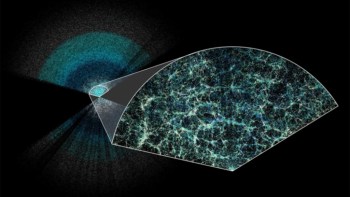
Global networks of quantum sensors could be used to search for hypothetical exotic low-mass field (ELF) signals that could be created during black-hole mergers and other violent astrophysical events. The proposal from a team of physicists in the US, Poland and Germany involves using the existing network of atomic clocks in the global positioning system (GPS) or an upgrade to a global network of optical magnetometers to search for ELF signals – which if detected, could provide important insights into what lies beyond the Standard Model of particle physics.
In August 2017 telescopes around the world were quickly trained on a small patch of sky where the LIGO–Virgo observatory had just spotted gravitational waves from the merger of two neutron stars. Astronomers were rewarded with a vast amount of information gleaned from a broad spectrum of electromagnetic radiation given off as the merging objects exploded in a kilonova. The success of this observation has intensified interest in multimessenger astronomy, whereby an astrophysical event is studied by detecting a range of “messenger” signals including gravitational waves, electromagnetic radiation, and particles such as neutrinos.
Now, Andrei Derevianko of the University of Nevada, Reno and colleagues have set a more ambitious goal: to do multimessenger astronomy with an unknown messenger.
Stripped away
Black holes and neutron stars have strong gravitational fields, so it stands to reason that they could attract dark matter. Indeed, several extensions to the Standard Model postulate that ELFs will cluster around large astrophysical objects such as black holes. Some of these could be stripped away by the huge release of energy during a merger and blasted towards Earth. Derevianko also points out that it could be possible that ELFs are created when two black holes merge – something that we cannot be sure about until we have a viable theory of quantum gravity.
As a result, trying to detect ELFs from these violent events offers a way of studying physics beyond the Standard Model. How to detect ELFs, however, would depend on their precise nature. Derevianko explains that using atomic clocks is one possibility: “You could write certain interactions in such a way that, for example, the fine-structure constant changes”. This would affect the Coulomb interaction, changing the energy level spacings within atoms, which would affect the frequency of an atomic clock. Conveniently, a worldwide network of atomic clocks already exists in the form of the global positioning system (GPS), and Derevianko and colleagues believe it could detect ELFs originating from anywhere in the observable universe.
Spin coupling
Another possibility is that ELFs could couple to spins, making them detectable by magnetometers. The Global Network of Optical Magnetometers for Exotic physics (GNOME) has 13 stations located on four continents: “At present levels of accuracy, magnetometers are not sensitive enough, but they can be in future – they are upgrading their magnetometers,” says Derevianko.
Even without knowing the precise nature of a hypothetical ELF signal, the researchers have predicted its shape and timing. As the particles would be highly energetic and have a very low (but non-zero) mass, they would be travelling at very close to the speed of light. Moreover, because of the frequency dispersion of outer space, the high frequency components would arrive first. The result, they say, is a tell-tale “anti-chirped” pulse that would arrive on Earth shortly after the gravitational waves.

Excitement grows over mysterious signal in dark-matter detector
In principle, says Derevianko, researchers could look for ELFs from events with no detected gravitational wave signal such as supernovae. If they were to find an ELF fingerprint of, for example, black hole mergers in GPS data, they could even trawl historical data in search of such patterns from before astronomers had the ability to detect gravitational waves.
Commenting on the work, Tien-Tien Yu of the University of Oregon says, “Because they’re an appealing dark matter candidate there’s been quite a lot of effort spent to look for these ELFs, but it’s hard”. She adds, “Typically if you have two black holes merging with clouds of dark matter around them, you might look for an X-ray signal, for example, from the dark matter annihilating or converting into photons or something like that. The fact that they’re trying to look for the dark matter itself rather than for photons is a bit different.”
The research is described in Nature Astronomy.



